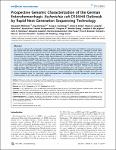Prospective genomic characterization of the German enterohemorrhagic escherichia coli O104:H4 outbreak by rapid next generation sequencing technology.
Mellmann, Alexander
Harmsen, Dag
Cummings, Craig A.
Zentz, Emily B.
Leopold, Shana R.
Rico, Alain
Prior, Karola
Szczepanowski, Rafael
Ji, Yongmei
Zhang, Wenlan
McLaughlin, Stephen F.
Henkhaus, John K.
Leopold, Benjamin
Bielaszewska, Martina
Prager, Rita
Brzoska, Pius M.
Moore, Richard L.
Guenther, Simone
Rothberg, Jonathan M.
Karch, Helge
An ongoing outbreak of exceptionally virulent Shiga toxin (Stx)-producing Escherichia coli O104:H4 centered in Germany, has caused over 830 cases of hemolytic uremic syndrome (HUS) and 46 deaths since May 2011. Serotype O104:H4, which has not been detected in animals, has rarely been associated with HUS in the past. To prospectively elucidate the unique characteristics of this strain in the early stages of this outbreak, we applied whole genome sequencing on the Life Technologies Ion Torrent PGMTM sequencer and Optical Mapping to characterize one outbreak isolate (LB226692) and a historic O104:H4 HUS isolate from 2001 (01-09591). Reference guided draft assemblies of both strains were completed with the newly introduced PGMTM within 62 hours. The HUS-associated strains both carried genes typically found in two types of pathogenic E. coli, enteroaggregative E. coli (EAEC) and enterohemorrhagic E. coli (EHEC). Phylogenetic analyses of 1,144 core E. coli genes indicate that the HUS-causing O104:H4 strains and the previously published sequence of the EAEC strain 55989 show a close relationship but are only distantly related to common EHEC serotypes. Though closely related, the outbreak strain differs from the 2001 strain in plasmid content and fimbrial genes. We propose a model in which EAEC 55989 and EHEC O104:H4 strains evolved from a common EHEC O104:H4 progenitor, and suggest that by stepwise gain and loss of chromosomal and plasmid-encoded virulence factors, a highly pathogenic hybrid of EAEC and EHEC emerged as the current outbreak clone. In conclusion, rapid next-generation technologies facilitated prospective whole genome characterization in the early stages of an outbreak.
Dateien zu dieser Publikation
Keine Lizenzangabe

